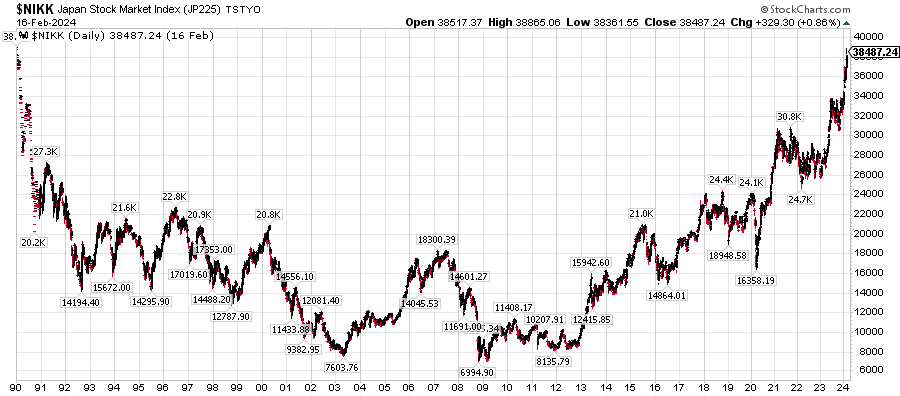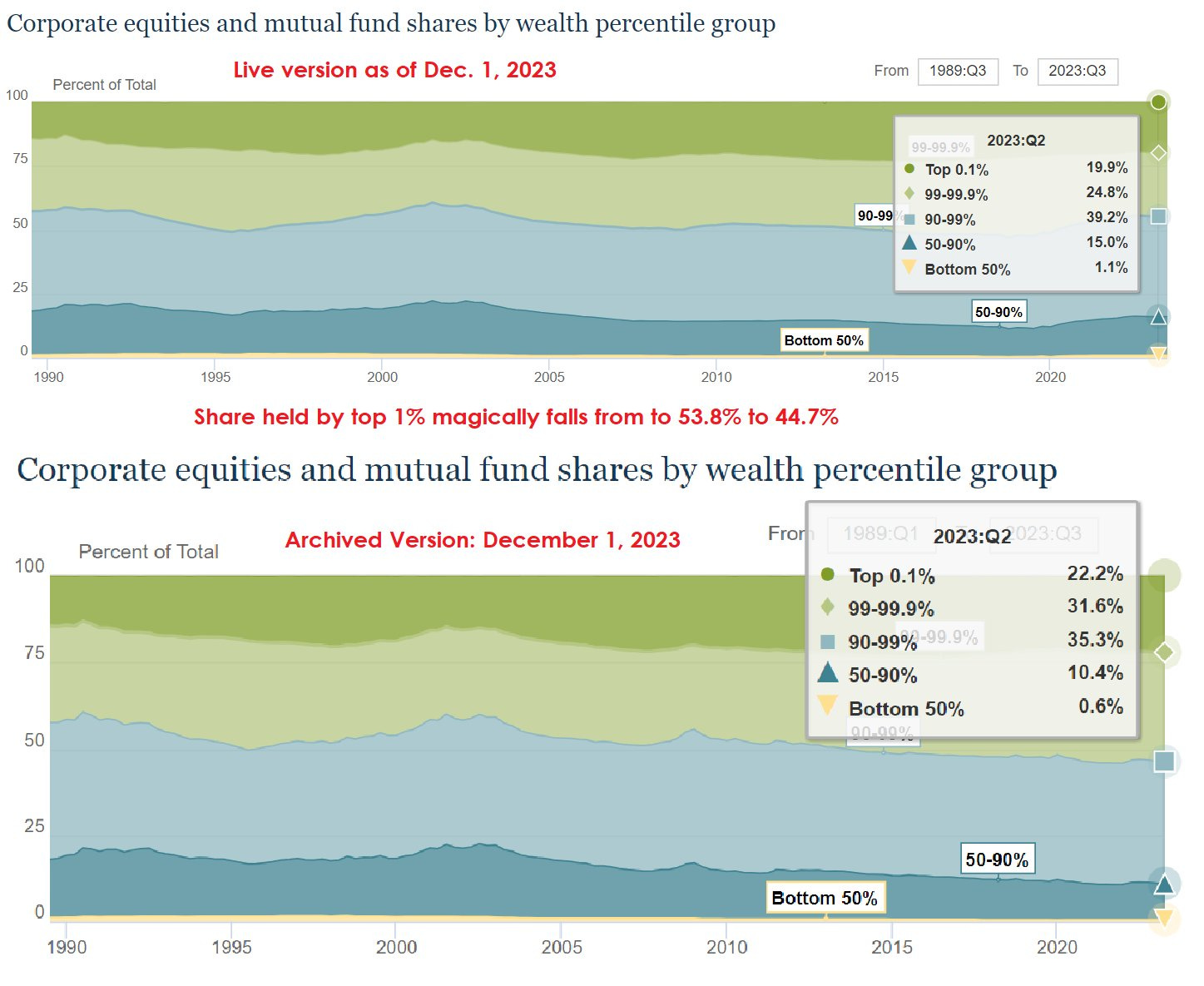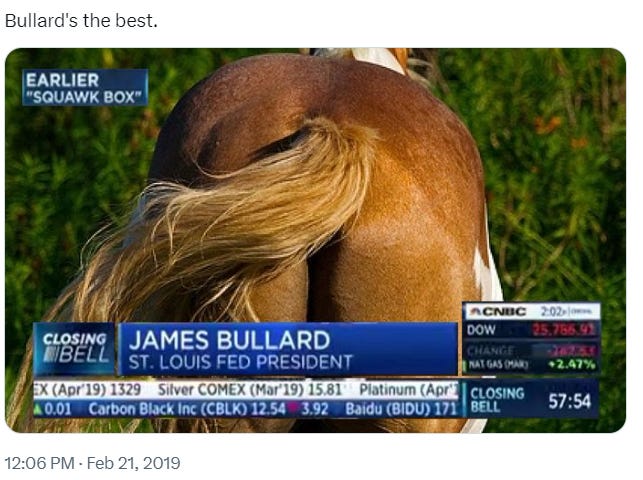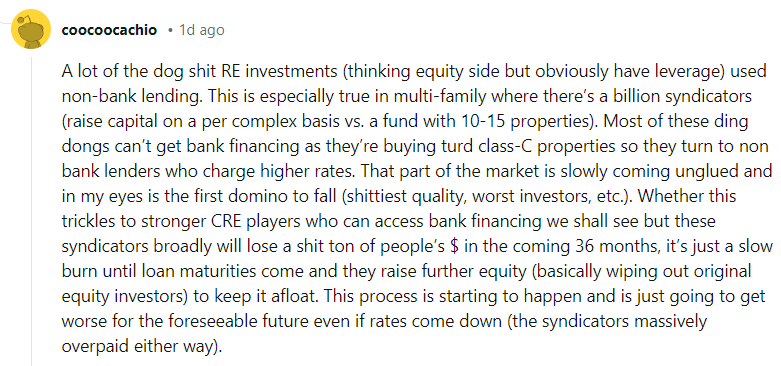So much going on - hope you enjoy today’s buffet.
The average net worth of me, Elon Musk, and Jeff Bezos is around $136 billion. The median is $194 billion.
Stocks for the (very) long run…
Friend of the show Weston Nakamura has been writing about the Nikkei lately…
“I've been making this analogy of Central planners basically being pilots in a plane where the instrumentation is increasingly off.”
I'm not a PhD economist, so I don't know what the wrong answer is, but I'm tired of seeing "data" (i.e., models) rejiggered to look better on the surface.
If you go back to Q1 2009, the old model below had the top 0.1% ownership at 20.1% (the new model now says 20.5%). The new model now has the top 0.1% owning 19.8% (Q3 2023), versus 22.2% with the old model.
The new model is saying the top 0.1% (and top 1%) have LOST share in the past 15 years. If you believe that, I have a bridge to sell you.
This is just for future historians. It is what it is.
Frankly, the old Fed model was likely wrong, and the new Fed model is likely wrong. The Fed has about 30,000 highly paid apparatchiks, most of whose sole job is to come up with things to keep them employed, leading to endless math models and pseudo-scientific papers. End this.
"Every record has been destroyed or falsified, every book has been rewritten, every picture has been repainted, every statue & street & building has been renamed, every date has been altered. And that process is continuing day by day and minute by minute."
George Orwell, 1984
Grant Williams puts out a great monthly newsletter.
In the latest Things That Make You Go Hmmm…
“More than 30 years ago, some relatively youthful central bank and Treasury economists in New Zealand were grappling with how to bring two decades of double-digit inflation under control in an economy less than 1% the size of its U.S. counterpart.
What if, they asked, they just told everyone the rate should be much lower - say roughly 2% - and then aim for that? “It was a bit of a shock to everyone, I think,” said Roger Douglas, the Labour Party finance minister at the time who worked with the Treasury and Reserve Bank of New Zealand (RBNZ) to pioneer the policy. “I just announced it was gonna be 2%, and it sort of stuck.”
Like that, inflation targeting was born.”
Again, here’s Jerome Powell a year ago trying to explain their made-up “2% target”:
As a reminder, the Fed’s legal mandate is “stable prices.” Here’s Jim Bullard in 2020:
No better argument for ending the Fed (or at least putting it on a tight leash) than Bullard’s comments above.
Podcasts
Chris Whalen, Peter Boockvar and Yra Harris on Market, Financial and Banking Risks and Trends
Can I can I chime on on this r-star1 thing?
R-star is econometric academia PhD mumbo jumbo. Powell doesn't know where the right level of reserves should be. He's also said I have no idea what r-star should be, and you know, historically, before 2008 and and going back 20, 30 years, the Fed funds rate was typically three to 400 basis points above the rate of inflation, and then somehow they created this r-star of 50 basis points so that if inflation's two, the ideal fed funds is two and a half, and now they think well, maybe, that neutral rate should be 200 or 250. I mean they're throwing darts at a wall here, which is which is scary but that's what they do.
- Peter Boockvar
“The economy, I think, when you look at it in totality, is weaker than the narrative suggests, and I'm sticking with that view.” - Dave Rosenberg
“I'm very happy to go with the trend once it begins but I'm happiest when I'm alone and when everybody disagrees.” - Kiril Sokoloff Same here.
The Trepp CRE podcast is very good but they always bend over backwards to be glass half-full (which, considering their client base, is understandable). They were so bullish back in August 2021 that I bookmarked that interview because I figured the CRE mania was near a peak. That said, this new one is one of their more sobering episodes.
The property owners at some level have some expectation that the government or whomever else is involved in the markets won't allow their losses to be fully realized. If they didn't think that way, you can't tell me that these Class B and C office buildings that are just literally functionally obsolete would be worth throwing any money after.
At this point - look, I'm an eternal optimist. I'm a free market guy. I want things to work well. I want the market to be efficient. I want everyone to make money, but it's just at some level the math just doesn't make sense, like, it just doesn't work, and even if the Fed cuts rates you dramatically from where they are now, I mean, we had like once in a generation type of interest rate environment when these deals were financed.
Let's try capitalism!
Plenty of buyers for all this stuff at a 𝘯𝘰𝘳𝘮𝘢𝘭𝘪𝘻𝘦𝘥 market price. Let's try to discover that price!
Many of these investors have been stockpiling funds since early in the pandemic. They have been frustrated because most property owners haven’t agreed to sell at big-enough markdowns, in large part because lenders have been willing to offer loan extensions and modifications.
Andrzej Skiba: The Rising Risks In “Private Credit” Lending Bonanza
The appeal that the returns of this asset class were definitely greater than what you could obtain in public markets. If you think about it, a few years ago, when rates were much lower, it was very difficult to get any kind of return within fixed income, so a double-digit type return, still being within fixed income , seemed quite attractive.
The other appeal of the asset class was to do with lack of mark-to-market accounting. When, as an investor in a public bond securities, I look at my portfolio at the end of the day, I need to price those securities and provide my investors with an update of how the portfolio is doing. You have price transparency, so you can see whether the market has gone up or down in a relatively short space of time.
Well, here you have no mark-to-market. You are shielded from market price fluctuations and the only times you need to make any adjustments to your valuation is either when the security is repaid, or if you have to write down the value of that security, but so far economic growth has been pretty robust and that has not happened. For for investors this combination of lack of mark-to-market and juicy returns was difficult to ignore.
I found Skiba’s comments on lack of transparency as being a good thing to be remarkable. Is it better to know your investment is down (or up) 50%, or to not know? Apparently ignorance is bliss.
Skiba:
“There's a reason why many of these companies did not have access to public funding. Public Funding like arguably it's cheaper to issue debt in public markets”
“If you are leveraged low or private credit company, the situation is very different, because with every rate hike, your cost of funding has increased. Right now, when we're looking at an average that these companies are paying in terms of their debt costs, well, we're talking about low-teens in percent terms, and that is a big deal.”
Jack: “A lot of these companies are owned by private-equity companies, so private credit funds are funding companies that are owned by private Equity”
“It always happens when a wall of money is hitting an asset class, whether that's equities, whether that's fixed-income, crypto - you name it - standards do fall as more and more money is chasing fewer and fewer opportunities, and what we have seen over the recent years is not only weakening of protections afforded within the direct lending documentation, but also lowering of extra compensation you are getting uh for investing within the asset class”
Jack: You said a lot of private credit deals are used to finance, you said, LBO’s, leveraged buyouts. That's private-equity, and then dividend recapitalization is that when private Equity investors pay themselves a dividend by borrowing money? When Apple pays a dividend, it's paying it from its profits.” Andrzej: “And here this is paid from debt.”
Just a few quotes. It’s a good interview worth listening too. Until 2022, we had over a decade of insane monetary policy and lending, and a historic buildup of debt, and most seem to think now that this is nothing like 2008, because we’re all so much more responsible now, or something. Dodd-Frank. Banks are well-capitalized. They didn’t do dumb things.
I don’t buy it. I feel like there has to be so many dead-men walking out there, but as someone said, things can go on longer than you can imagine. I think that was George W. Bush.
e.g.,
On a related note…One possible future. From your point of view. I don't know tech stuff.2
“Credit union net charge-off ratio surges to decade high”
“The net charge-off (NCO) ratio for credit unions was 0.77% in the fourth quarter of 2023, 16 basis points higher sequentially and representing the peak since the first quarter of 2012. The majority of the $670.9 million quarterly jump in NCOs was from used vehicles and unsecured credit cards. NCOs for used vehicles were up 36.1%, or $219.4 million. Unsecured credit card NCOs increased 30.5%, or $222.7 million.”
Single Family Starts Up 22% Year-over-year in January; Multi-Family Starts Down Sharply
Long-Distance Movers Targeting Less Competitive, Less Expensive Housing Markets
Some comments from the hoi polloi:
These active inventory numbers are amazing.
Between Geithner’s moves post-GFC, Covid, and horrific monetary policy, they really screwed up the U.S. housing market.
Bank loss reserves to delinquent loans
“I manage 400+ Single Family Rental Homes. What I am seeing now”
Been in the business for 10+ years. In the "workforce rental home" management sector. Not ghetto but definitely not luxury.
Rents are up obviously from a few years a go, now they are flat at best, even down a hair.
Costs are ASTRONOMICALLY HIGH. Materials/labor/insurance/mortgage costs/legal costs you name it.
Affordability has become very difficult for a number of tenants in our portfolio. Evictions are up.
Disdain for landlords and our tenants attitudes towards management is high. We service our rentals very well, full time maintenance staff in the field daily. At your door within an hour during day time for service calls. And still we are constantly verbally abused and treated like trash.
Tenants are often refusing to pay rent and forcing a court date. At court they will make up fake repairs to the judge to buy time for free rent. This drives up the cost of us to do business and in turn drives up rents.
Bounced rental payments are now a daily occurance. Most tenants respond with "your bank messed up not mine".
The cities have become harsher on us with rental inspections/permits. Added costs.
We are in eviction court 3 times per week. It is more and more crowded weekly. Affordability has become a major issue with tenants, and looking at the numbers the company is not making record profits. Net income is down due to all of expenses going up.
Our costs keep going up, tenant quality is becoming worse and worse. We are unable to raise rents to off set costs or tenant issues any longer. A lot of landlords getting out of the business and selling, less rentals available driving up rents that people can not afford. Something is going to break.
Santa Monica City Council approves new tenant laws
Commentary from broker Taylor Avakian:
“Here are the highlights:
This covers all housing. Including non-rent-controlled buildings.
If an owner increases rent by CPI +5% or 10%, the owner must pay a relocation fee if the renter chooses to move
If a renter vacates and claims it was due to harassment, illegal lockouts, uninhabitable conditions, or other constructive situations, an owner may pay a permanent relocation fee
Owner are required to offer buyout agreements no less than city defined fee.
If you try to buy a tenant out twice within 6 months, they can sue you.
$20,000 per violation fee
Landlords may no longer refuse to accept housing vouchers from renters
Also being drafted is the inability of a landlord to evict a tenant for unpermitted work on a unit.
For reference, the current relocation fees are: Single: $18,250, One Bed: $25,150, Two +: $34,950
If you want to move into your own unit, yep, still paying the fees.
I'm all for protecting renters from scummy landlords but some of the language in this is so vague that even a good landlord with a bad tenant can get screwed.”
I can’t imagine wanting to be a residential landlord in California.
“A near 50% markdown on average”
“The share of office commercial mortgage-backed-security debt classified as distressed (i.e, more than 30 days past due or loans which have been transferred to a special servicer) reached 10.5% at the end of January, data from CRED iQ show, more than triple the tally seen a year ago.
Steep valuation declines can be expected to follow for those troubled assets, as a collection of office properties tracked by Cred iQ that were reappraised by a special servicer last year saw a near 50% markdown on average.”
The amount of CRE debt maturing this year has increased from $659 billion to $929 billion due to lenders granting extensions and modifications to loans over the past few years and Fed officials have made clear that interest rate cuts won’t happen before March…
As of the third quarter of 2023 there was $79.6 billion in outstanding distressed properties. Of that, office was 41%; retail, 27%; hotel, 17%; multifamily, 9%; and industrial, 2%. Going into 2024, though, they say that the potential distress could be as much as $215.7 billion, or “larger than the cumulative distress observed during the entirety of the Great Recession.”
…There were some positives. As property values skyrocketed, so did rents. That appreciation insulated loan-to-value ratios. Implied LTVs for accumulated appreciation and outstanding loan balances for properties purchased between 2010 and 2019 was 51.5%. That is a sizeable cushion, but probably not for the properties owners bought with high leverage and low interest between 2020 and 2022.
“It really comes down to what your underwriting assumptions were,” Benjamin Jacobson, one of the two partners at Forman Capital, tells GlobeSt.com.
Predictions by some experts that the nation’s current oversupply of apartments will decline by the end of 2024 are not supported by a new analysis from Yardi Matrix.
Instead, Yardi proclaimed, “the under-construction pipeline is robust, and elevated deliveries are anticipated for 2024 and 2025.” In all, 766,353 units are still scheduled for completion by as late as early 2026. That is a 9.9% quarter-over-quarter and 36.6% year-over-year increase. In addition, 483,207 units were in lease-up in Q1 2024 — for a total of 1.25 million units under way.
Yardi attributed these high levels to elevated completion times, with days in construction for both garden and midsize properties at or near record levels. In 4Q 2023, the national average time to build a garden-level property was 697 days, compared to the annual trailing average of 678 days. For midsize properties, construction time rose from 738 to 770 days. High-rise completion times have reverted to pre-pandemic levels.
Nevertheless, “a gradual but not disastrous slowdown in multifamily development is taking hold,” Yardi opined, noting that new supply should bottom out in 2026.
“This index is a leading indicator primarily for new Commercial Real Estate (CRE) investment:”
The landmark Montgomery Park building in Northwest Portland changed hands for a $37.7 million credit bid Wednesday in a foreclosure auction.
In 2019, it sold for $255 million.
The bargain price points to the woeful state of Portland’s commercial real estate market. Not a single outside bidder submitted an offer Wednesday to buy the hulking office building in Northwest Portland. As a result, it will go to the lender, New York-based Natixis.
The auction was much anticipated as an indicator of the state of the office market in the city. A small group of about 20 braved the cold wind outside the Multnomah County Courthouse to watch in person. One onlooker brought a tub of popcorn which he shared with the crowd.
This is fine:

Nuclear Power Capacity in Germany by Year

"Look at Germany. No one spent more money than Germany on wind and solar. They're burning coal and wood. It's not different than what they did in the 16th century." - Adam Rozencwajg
In my last post I threw in a positive-looking Bloomberg bankruptcy chart (mostly to seem less gloomy) - thanks to Melody Wright for providing a more comprehensive overview in her comments here.
‘Bizarre Valedictory Interview by CalSTRS Investment Chief, Chris Ailman, Asks Private Equity to Be Nice and Share with Workers’
…Limited partners like CalSTRS, who are, in Wall Street parlance, the money, have not even been able to get basic disclosures from the general partners like how much in total the private equity firms hoover out in fees and expenses, despite many years of pleading. Mind you, it’s a requirement for a fiduciary to evaluate the costs and risks of any investment, yet these investors have accepted this abuse.
Limited partners don’t get P&Ls of portfolio companies. They don’t get independent valuations even though that is considered to be essential for every other type of investment. So it’s ludicrous to think that general partners will share money with one of the very weakest parties in the picture, mere workers, when they won’t give information to the limited partners.
Someone new to this topic might wonder why limited partners don’t say “no”. The reason is they perceive private equity to be necessary for them to earn enough to reduce their level of underfunding, which in the public pension fund world is typically pretty bad. To make up for the shortfalls, pension funds like CalPERS and CalSTRS have also been increasing the amount they charge to cities, counties, and other local government entities. These pension costs are taking up larger and larger proportions of these budgets, creating concern and anger.
Investors like Ailman haven’t even worked out that private equity has been selling them the rope with which they are hanging themselves. Private equity pay and manning-level squeezing crimps incomes, and with it, all sorts of government revenues that derive from income and sales taxes. The more than occasional bankruptcy kills jobs and often puts commercial and residential real estate on the market, hurting values and thus over time, property taxes. One can’t know for certain how much, but communities all over California would be better off if private equity predators were not stalking the land.
…Many studies, when you carefully cut their metrics, have effectively found that private equity has not out-performed on a risk-adjusted basis since the early 2000s, potentially even the last glory year of PE, 1999…In other words, to the extent private equity does outperform, the general partners suck it all out for themselves.
…It’s striking that Aliman didn’t advocate for the most obvious way to redistribute at least some wealth away from private equity to communities at large: ending the carried income loophole, which has the effect of allowing private equity barons to have ginormous amounts of ordinary income taxed at capital gains rates.
Good commentary. I am not a fan of private-equity as it exists.
"First, private equity firms typically buy businesses only for the short term. Second, they often load up the companies they buy with debt and extract onerous fees. And third, they insulate themselves from the consequences, both legal and financial, of their actions."
I've been seeing James Altucher popping up again lately. I'm reminded of this Felix Salmon piece from 2011: "Annals of white-collar crime, James Altucher edition"
The original has been scrubbed, seemingly from search engines as well.
The Economic Organisation of a P.O.W. Camp By R.A. RADFORD
By the end of a month, when we reached our permanent camp, there was a lively trade in all commodities and their relative values were well known, and expressed not in terms of one another-one didn't quote bully in terms of sugar-but in terms of cigarettes. The cigarette became the standard of value. In the permanent camp people started by wandering through the bungalows calling their offers - "cheese for seven" (cigarettes) - and the hours after parcel issue were Bedlam. The inconveniences of this system soon led to its replacement by an Exchange and Mart notice board in every bungalow, where under the headings "name", "room number", "wanted" and "offered," sales and wants were advertised. When a deal went through, it was crossed off the board.
The public and semi-permanent records of transactions led to cigarette prices being well known and thus tending to equality throughout the camp, although there were always opportunities for an astute trader to make a profit from arbitrage. With this development everyone, including non-smokers, was willing to sell for cigarettes, using them to buy at another time and place. Cigarettes became the normal currency, though, of course, barter was never extinguished.
“I guess technically something can't be a Black Swan if you already see it, right?”
Nice Bitcoin ETF rant by friend of the show Jim Bianco!
Mike Benz: The national security state is the main driver of censorship and election interference in the United States. "What I’m describing is military rule," says Mike Benz. "It’s the inversion of democracy."
Recommended. Transcript.
David Woo with Julia La Roche
Americans should listen to Woo's thoughts on how the rest of the world views the U.S.
“It scares me, because it tells me that there are many more anti-Americans than there are actually pro-Americans out there, okay?” - Woo
The Fed defines r-star as “the real short-term interest rate expected to prevail when an economy is at full strength and inflation is stable.”
Terminator, 1984




























At this point, the 4th turning cannot come soon enough, as long as part of the process is the rounding up of every one of these government parasites and removing them to an island where no fossil fuels or products made from fossil fuels are available. they will remain incommunicado and die swiftly making the world a far better place
I was a commercial lender in community banks in my career, later a safety and soundness bank examiner with two of the three federal agencies until 2019. While a lender I remember a lawyer in Connecticut I worked with coming out of a closing in late 2005 and saying, “I am calling it now, peak stupid. New mortgage with 90% LTV and HELOC to 125%. It’s downhill from here.” Both of us had been through late 80’s 90’s S&L meltdown. He was right. No big fish lost their Hampton home, went to jail, Paulson bailed the big guys out, the Patriot Act gets extended. Like Tom Luongo I am long Gold, Goats and Guns.